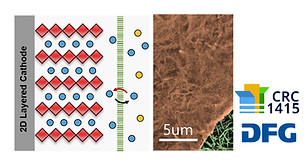Projects
CRC1415: B10 project
Funding agency: Deutsche Forschungsgemeinschaft (DFG)
Duration: 2024.07-2028.06
Budget: 254,100 Euro

Two-dimensional polymer (2DP) membranes hold the promise to achieve high ion conductivity and selectivity simultaneously, which opens exciting application possibilities in various ion-involved technologies. This project aims to correlate the chemical structure, ion transport property, and artificial interphase function of 2DP membranes exclusively developed within this CRC consortium. The project aims to establish a profound structure-property-function relationship for 2DP membranes, paving the way for their utilization in various electrochemical systems.
ERC-STG: BattSkin
Funding agency: European Commission
Duration: 2023.12-2028.11
Budget: 1,499,900 Euro

The intrinsic limitation of Li-ion batteries (i.e., cost, safety, and sustainability) is imposing a strong demand for next-generation battery technologies based on resource-abundant elements. Among the top candidates for this purpose are Mg batteries. However, state-of-the-art Mg batteries still encounter numerous problems (e.g., low Coulombic efficiency, energy efficiency, energy density, and cycle life) and are far from mature enough to satisfy practical use. The disappointing performance of Mg batteries is dominantly assigned to the problematic interfacial charge transfer governed by the charge-dense Mg-ion at both the anodes and cathodes. The BattSkin project seeks to advance next-generation sustainable battery technology by exploring the application of precise polymer chemistry to govern the interfacial ion dynamics in Mg batteries.
SMWK: DCC-junior group
Funding agency: Sachsen SMWK
Duration: 2021.10-2023.03
Budget: 220,517 Euro

Understanding and controlling ionic transport in energy storage devices is fundamentally significant and challenging. Although early studies have detected interesting ionic transport phenomena in electrode materials, the underlying fundamentals in terms of different interactions (e.g., ion-ion, ion-solvent, ion-channel interactions) and their influence on ionic transport behaviors are still not clearly understood. In this regard, the structural simplicity and tunability of layered and 2D materials (e.g., graphene and MXenes) provide desirable feasibility to enrich the fundamental understanding of the ionic transport behaviors in nanochannels, which could be directly translated into large-scale real-world energy storage applications.